 "Off Dover, The Merchantman John O'Gaunt in Two Positions", by Robert Dodd, 1811 | |
| History | |
|---|---|
| Name | John O'Gaunt |
| Namesake | John O'Gaunt |
| Owner | Worswick & Co.[1] |
| Builder | John Brockbank, Lancaster, Lancashire |
| Launched | 1809 |
| Fate | Scuttled December 1813 |
| General characteristics | |
| Tons burthen | 419,[2] or 426,[1][3] (bm) |
| Complement | |
| Armament |
|
John O'Gaunt was a merchant ship launched in 1809 that traded with the West Indies. The French frigate Clorinde captured and scuttled John O'Gaunt in 1813.
On 7 July 1809, Captain Robert Gibson received a Letter of marque for John O'Gaunt.[3] Under his command, and later under the command of James Moon, who received a letter of marque on 23 March 1810,[3] she made several voyages as a West Indiaman. On 1 November 1811, as she was sailing from London to Cork and Barbados, she lost an anchor in The Downs.[4]
On 27 November 1813 John O'Gaunt, P. Inglis, master, and four other merchant vessels left Portsmouth in a convoy under escort by HMS Severn. The other four were:
- Blendon Hall, 473 tons (bm), Barr, master, which had been sailing from London to Bermuda;
- Lusitania, 245 tons (bm), Johnston, master, which had been sailing from London to Suriname;
- Aurora, Scheidt, master, which had been sailing to Amelia Island; and,
- Superb, 130 tons (bm), R. Roberts, master, which had been sailing from Gibraltar to England.
Due to a heavy storm, the five merchantmen lost contact with the convoy and its escort. On 6 December Clorinde captured all five merchant vessels,[5] in the Atlantic Ocean (44°30′N 10°30′W / 44.500°N 10.500°W). The French took off the crews of four vessels and scuttled three. In their haste, they failed to sink Blenden Hall properly, leaving her floating. They kept Lusitania as a cartel and put all their captives aboard her. They then permitted Lusitania to sail to a British port.[5] She arrived at Plymouth on 18 December.[6]
John O'Gaunt's entry in the Register of Shipping for 1814 carries the notation "CAPTURED".[2]
Citations
- 1 2 Lloyd's Register (1809), Supple. Seq. №J41.
- 1 2 3 Register of Shipping (1814), Seq. №690.
- 1 2 3 4 5 6 7 "Letter of Marque, pp.70-1, accessed 25 July 2017" (PDF). Archived from the original (PDF) on 20 October 2016. Retrieved 14 August 2017.
- ↑ Lloyd's List №4612. Accessed 6 December 2016.
- 1 2 Senior (1911), pp. 180–182.
- ↑ Lloyd's List №4831.
References
- Senior, W. (1911). "The Rivals". Mariner's Mirror. 1 (7): 180–182. doi:10.1080/00253359.1911.10654516.